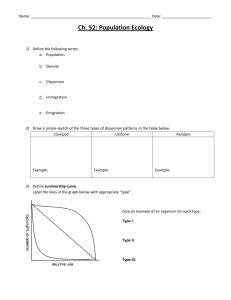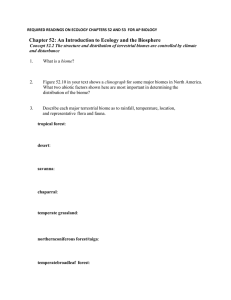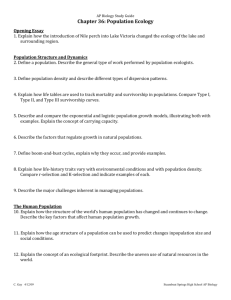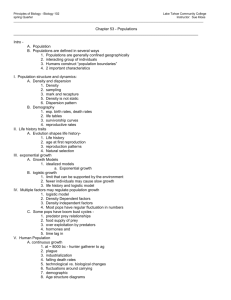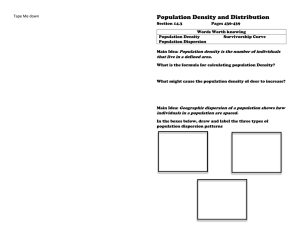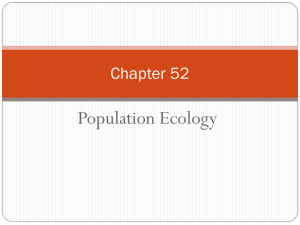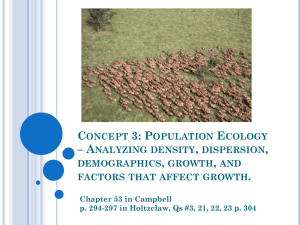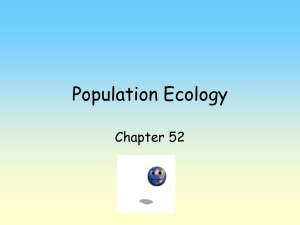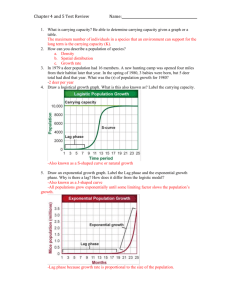Population Ecology
advertisement
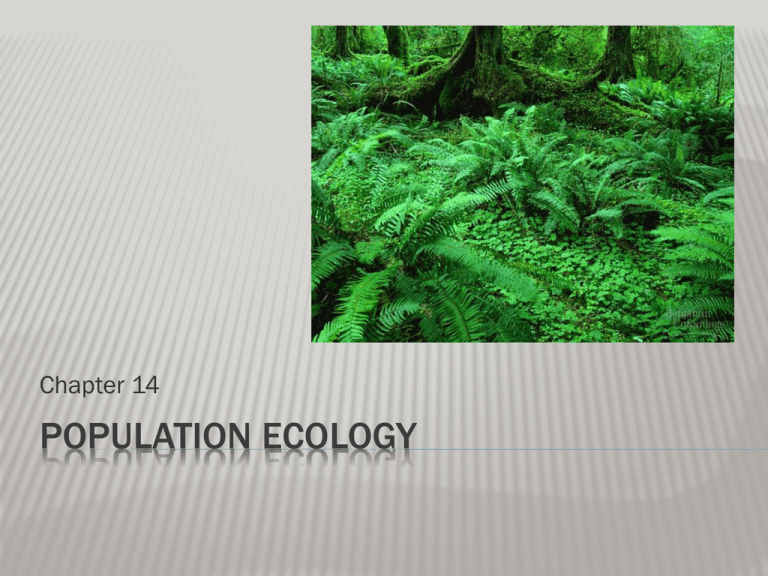
Chapter 14 POPULATION ECOLOGY POPULATION ECOLOGY What is a population? A group of individuals of the same species that live in a given area Area is defined. Ex. Voter population could be just Spearfish or United States Population Ecology Changes in a population and the biotic and abiotic factors that influence those changes Organism Population Community Ecosystem POPULATION DISPERSION PATTERNS Population density # ind of a population/ unit area or volume Clumped dispersion Uniform dispersion Random dispersion WHAT DISPERSION PATTERN WOULD YOU PREDICT FOR A TERRITORIAL CHIPMUNK SPECIES? a) b) c) Clumped Uniform Random •Maximized rate with perfect conditions •Growth rate (G) = rN = average rate of increase per individual in the population X pop size •Population size increases exponentially •Population can outstrip its resources and crash EXPONENTIAL GROWTH Resource availability limits population growth. Population growth following the logistic model stabilizes around the carrying capacity (K) of the environment. G = rN(K-N)/K (K-N)/K = the closer N comes to the carrying capacity, the slower the rate of growth LOGISTIC GROWTH WHICH OF THE FOLLOWING IS AN EXAMPLE OF A POPULATION? A) all of the microorganisms on your skin B) all of the species of cichlid fish in Lake Victoria C) all of the students in your classroom D) all students attending colleges and universities in your state E) the various plants found in prairies in the western United States THE DECLINE OF THE NILE PERCH IN LAKE VICTORIA IN EAST AFRICA AND THE REEMERGENCE OF CICHLIDS IS AN EXCELLENT SITUATION FOR STUDY BY A) geologists. B) ecologists. C) population ecologists. D) geographers. E) population geneticists. SUSTAINABLE RESOURCE MANAGEMENT FOOTPRINT ECOLOGICAL FOOTPRINT – GHA – GLOBAL HECTARE Cockroach population - influenced by short generation time - high reproductive rate (females lay lots of eggs) Sustainability research helps give insight into how to control populations. - mature female individuals contribute most to population growth - target females for biggest impact LIFE TABLES AND SURVIVORSHIP Types of survivorship curves: I = most individuals live to old age II = equal probability of dying through out life span III = rapid die off of young, few individuals live to old age AGE STRUCTURE CAN HAVE AN IMPACT CONSIDER A STABLE FROG POPULATION LIVING AT CARRYING CAPACITY IN A POND. IF AN AVERAGE FEMALE PRODUCES 6,000 EGGS DURING HER LIFETIME AND AN AVERAGE OF 300 TADPOLES HATCH FROM THESE EGGS, HOW MANY OF THESE TADPOLES WILL, ON AVERAGE, SURVIVE TO REPRODUCE? A) 0 B) 2 C) 10 to 20 D) 100 E) more than 100 IF A POPULATION HAS A BIRTH RATE OF 40 INDIVIDUALS PER 1,000 PER YEAR AND A DEATH RATE OF 30 INDIVIDUALS PER 1,000 PER YEAR, HOW WILL THE POPULATION CHANGE EACH YEAR? (ASSUME THAT THE POPULATION IS BELOW CARRYING CAPACITY AND THAT THERE IS NO IMMIGRATION OR EMIGRATION.) A) It will decrease by 70%. B) It will increase by 1%. C) It will increase by 5%. D) It will increase by 70%. E) It will increase by 100%. READ CHAPTER 15 – ECOSYSTEMS & COMMUNITIES

